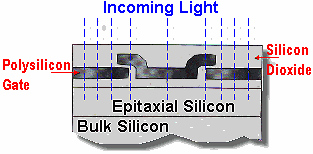

ITO, A new Technology
improves Blue/Green Sensitivity of Frontside-Illuminated CCDs
Among the most important measurable characteristics associated with CCDs is quantum efficiency. Quantum efficiency (QE), often expressed as a percentage, indicates the effectiveness of an imager to produce electronic charge from incident photons. The greater the QE at a given wavelength, the more efficient the imager at that wavelength.
 In
an effort to boost the sensitivity of frontside-illuminated CCDs in the blue/green
region of the spectrum, the Eastman Kodak Company has pioneered a new gate structure
based on indium tin oxide (ITO). Indium tin oxide was a logical candidate for
a new gate material, as it has been used for many years to provide a clear conductive
coating in a wide variety of applications. Before discussing the latest wrinkle
in ITO technology and its impact on certain imaging applications, it is useful
to first review the blue/green sensitivity issue.
In
an effort to boost the sensitivity of frontside-illuminated CCDs in the blue/green
region of the spectrum, the Eastman Kodak Company has pioneered a new gate structure
based on indium tin oxide (ITO). Indium tin oxide was a logical candidate for
a new gate material, as it has been used for many years to provide a clear conductive
coating in a wide variety of applications. Before discussing the latest wrinkle
in ITO technology and its impact on certain imaging applications, it is useful
to first review the blue/green sensitivity issue.
The majority of commercially available CCDs are frontside-illuminated devices made from silicon. In a frontside-illuminated CCD, light passes through the polysilicon gates that define a charge well at each pixel. While the gates transmit a number of the incident photons to the CCD's photoconversion layer, they will also reflect and absorb a fraction of photons, thereby preventing some light from reaching the pixel's photosensitive region. For gates made from polysilicon, the transmission starts to drop at wavelengths shorter than 540 nm and is essentially zero below 400 nm. Therefore, frontside-illuminated sensors have a particularly low QE in the blue/green region of the spectrum.
One approach to resolving the blue/green sensitivity issue is to use a thinned, backside-illuminated CCD instead of a frontside-illuminated device. Employing acid-etching techniques, it is possible to uniformly thin a CCD to a thickness of approximately 10 µm and focus an image on the backside of the CCD register, where there is no gate structure. Compared to conventional frontside-illuminated CCDs, thinned devices have a higher QE across the entire visible spectrum (400 - 700 nm), including far superior sensitivity in the blue/green region.
Kodak's Microelectronics Technology Division has developed a new fabrication process that produces gates that are more transparent to light. Based on indium tin oxide, these gates provide higher light throughput into the photoconversion layer of the CCD. The resultant imaging devices have higher QE levels than those attainable with conventional frontside-illuminated CCDs. This improvement extends across the visible spectrum, including the blue/green region.
The quantum efficiency of ITO imagers in the blue/green region exceeds the QE performance generally seen in lens-on-chip and open-electrode designs. Furthermore, ITO devices have no inherent reduction of dynamic range and carry a fairly comparable price tag. All three of these designs are outperformed by backside-illuminated CCDs in terms of quantum efficiency, but as was pointed out earlier, price and availability may be the largest issues when considering thinned devices. Overall, ITO technology represents an excellent " price and performance" option for many low-light-level applications that require imaging in the blue/green, including green fluorescent protein (GFP) imaging, chemiluminescent imaging, and fluorescence in situ hybridization (FISH).